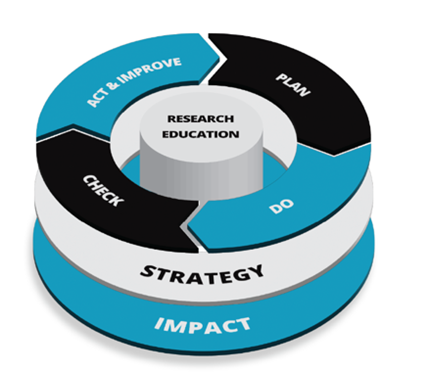Quality management is an essential part of UEF’s strategic management
UEF’s quality system functions with a well-documented, thoughtful procedure for planning and decision making in place. The UEF quality policy is described with key principles and published on the UEF intranet and its public web pages both in Finnish and English. The idea of UEF as an organization that works in a quality manner, evaluating practices with data and using those evaluations to drive future practices, was evident across multiple units through different interviews. The UEF board is responsible for the university’s quality principles and policies.
Based on the interviews, university staff recognize the connection of their own work with the goals and strategy of UEF. The audit team heard several times of staff knowing the strategic goals and how they are related to their work. All interviewed groups were able to discuss the university strategy, which was very impressive.
The audit team considers it to be a strength that UEF has based the development of the quality system on feedback from the previous FINEEC audit (2016) together with the university’s own development needs. A positive view emerged from the SAR and interviews on how the university included feedback into the quality management system. One example is how UEF reformed the quality organisation to reflect the current organisation, and another is the steps to streamlining the quality system. The quality system being based on plan-do-check-act/improve cycle to ensure continuous development is a well-functioning model for a university’s quality management system. The audit team recognizes the enhancement activities listed in the SAR as strengths, and in the interviews a picture of visible leadership that was engaged with the university environment emerged.
UEF’s integrated quality management model shows that quality management is an essential part of strategic management at all levels within the university. The quality system is not run as a top-down structure, but instead integrated into the structure of the university. Each level of the organization has staff that recognizes their responsibilities for quality work in their area. At UEF, the integration of quality management into the whole organization was emphasized, and the audit team considers this structure a strength. At the same time, it was shared in interviews that quality work could be made more visible. For example, the university could more often describe how the loop is closed in the plan-do-check-act/improve cycle. In particular, the part “improve” of the loop could be made more visible. This way the staff, students, and external stakeholders could see that quality work has an effect on making changes. The audit team thus encourages UEF to make quality work related to quality assurance more visible, including its results and usage in improvement.
Leaders from the rectorate to departments use both quantitative and qualitative data to evaluate core activities and make data-based decisions in a knowledge-management informed framework. This work is largely performed independently within each unit but is guided at the university level through the quality group. Given the distributed nature of the quality system, having a group that can facilitate coordination and perform quality assurance work on quality analyses is important. The quality group is composed of the people responsible for quality work in units across campus. The role and responsibility of the quality group will be further discussed in section 3.3.
The quality system supports the implementation of UEF’s strategy
With a well-known strategy and a strong will and engagement for its implementation, a solid basis is formed for a more strategic approach for the university to steer and guide the university towards its vision. The audit visit observed that a culture among staff and students striving for quality permeates the organization. Internal audits with strong leadership engagement were cited as being useful for quality work and linked to strategic management. Individuals were able to cite examples of using data, often a mix of qualitative and quantitative, to make decisions and strive for quality. While data is used by people in charge of quality in the faculties and units, more systematic use of strategic indicators, either quantitative or qualitative, would ensure a more effective implementation of the strategy and facilitate the university community moving in a common direction.
To expand on the recommendation to make quality work more visible, the audit team recommends developing strategic indicators supporting the profile of the university and using these indicators in strategic management – an idea already mentioned in the SAR as an enhancement area. These strategic indicators will need to be carefully crafted to support the multidisciplinary approach and varied units of the university. The audit team suggests that the indicators should be collaboratively developed so they will be better accepted by the university community and more widely known.

